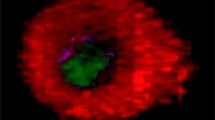Abstract
Purpose
Identification and localization of biomolecules in cells and tissue samples are important for understanding of subcellular structures and can be helpful in biomedical and pharmaceutical research.
Procedures
Isolated cardiac cells and tissue of rats are studied by using time-of-flight secondary ion mass spectrometry. This technique provides chemical composition of cardiac cell membrane and tissue surface in native form.
Results
The result is a spatially resolved chemical imaging of cell and tissue surfaces as a lateral distribution of biologically relevant molecules—phospholipids, along with fatty acids, and cholesterol. Phospholipids are represented by phosphatidylcholine and cardiolipin molecules and their fragments. Phosphatidylcholine polar head group at mass of 184.1 u has an origin in the cell membrane, and a two-dimensional distribution of this fragment provides clear chemical contours of the cell. The high-resolution contrast of the cell is observed within its environment represented with Na+ ions. Images of PO4H− fragment and fatty acids with 16 or 18 C atoms are determined in cardiac tissue. Distributions of these 16 and 18 C fatty acids are the same within their groups, and interestingly, these two distribution groups are spatially complementary. Contours of phosphatidylcholine and cardiolipin fragments are also complementary, the distributions of 16 C fatty acids and phosphatidylcholine are identical, and the distributions of 18 C fatty acids and cardiolipin are also the same. This complementarity thus supports the chemical compositions of phosphatidylcholine and cardiolipin based on 16 C and 18 C fatty acids, respectively.
Conclusion
The method provides information not only about cell and tissue morphology, shape, and condition but also about cellular membrane chemical composition and lateral distribution of biologically relevant molecules.






Similar content being viewed by others
References
Magnani A, Priamo A, Pasqui D, Barbucci R (2003) Cell behaviour on chemically microstructured surfaces. Mat Sci Eng C 23:315–328
De Stasio G, Frazer BH, Girasole M, Wiese LM, Krasnowska EK, Greco G, Serafino A, Parasassi T (2004) Imaging the cell surface: argon sputtering to expose inner cell structures. Microsc Res Tech 63:115–121
Passey S, Pellegrin S, Mellor H (2007) Scanning electron microscopy of cell surface morphology. Curr Protoc Cell Biol, Chapter 4, unit 4.17
Touboul D, Kollmer F, Niehuis E, Brunelle A, Laprevote O (2005) Improvement of biological time-of-flight-secondary ion mass spectrometry imaging with a bismuth cluster ion source. J Am Soc Mass Spectrom 16:1608–1618
Jones EA, Fletcher JS, Thompson CE, Jackson DA, Lockyer NP, Vickerman JC (2006) ToF-SIMS analysis of bio-systems: are polyatomic primary ions the solution? Appl Surf Sci 252:6844–6854
Debois D, Brunelle A, Laprevote O (2007) Attempts for molecular depth profiling directly on a rat brain tissue section using fullerene and bismuth cluster ion beams. Int J Mass Spectrom 260:115–120
Borner K, Malmberg P, Manson J-E, Nygren H (2006) Molecular imaging of lipids in cells and tissues. Int J Mass Spectrom 260:128–136
Richter K, Nygren H, Malmberg P, Hagenhoff B (2007) Localization of fatty acids with selective chain length by imaging time-of-flight secondary ion mass spectrometry. Microsc Res Tech 70:640–647
Johansson B (2006) ToF-SIMS imaging of lipids in cell membranes. Surf Interface Anal 38:1401–1412
Ostrowski SG, Kurczy ME, Roddy TP, Winograd N, Ewing AG (2007) Secondary ion MS imaging to relatively quantify cholesterol in the membranes of individual cells from differentially treated populations. Anal Chem 79:3554–3560
Debois D, Bralet MP, Le Naour F, Brunelle A, Laprevote O (2009) In situ lipidomic analysis of nonalcoholic fatty liver by cluster TOF-SIMS imaging. Anal Chem 81:2823–2831
Benabdellah F, Seyer A, Quinton L, Touboul D, Brunelle A, Laprevote O (2010) Mass spectrometry imaging of rat brain sections: nanomolar sensitivity with MALDI versus nanometer resolution by TOF-SIMS. Anal Bioanal Chem 396:151–162
Sjovall P, Lausmaa J, Nygren H, Carlsson L, Malmberg P (2003) Imaging of membrane lipids in single cells by imprint-imaging time-of-flight secondary ion mass spectrometry. Anal Chem 75:3429–3434
Aranyosiova M, Chorvatova A, Chorvat D Jr, Biro C, Velic D (2006) Analysis of cardiac tissue by gold cluster ion bombardment. Appl Surf Sci 252:6782–6785
Wagner MS, Castner DG (2001) Characterization of adsorbed protein films by time-of- flight secondary ion mass spectrometry with principal component analysis. Langmuir 17:4649–4660
Chorvat D Jr, Bassien-Capsa V, Cagalinec M, Kirchnerova J, Mateasik A, Comte B, Chorvatova A (2004) Mitochondrial autofluorescence induced by visible light in single rat cardiac myocytes studied by spectrally resolved confocal microscopy. Laser Phys 14:220–230
Acknowledgement
This research was supported by ERDF OP R&D, Project “QUTE-Centrum excelentnosti kvantových technológií” and APVV-0491-07.
Conflict of Interest
The authors have no conflicts of interest.
Author information
Authors and Affiliations
Corresponding author
Rights and permissions
About this article
Cite this article
Jerigova, M., Biro, C., Kirchnerova, J. et al. Chemical Imaging of Cardiac Cell and Tissue by Using Secondary Ion Mass Spectrometry. Mol Imaging Biol 13, 1067–1076 (2011). https://doi.org/10.1007/s11307-010-0460-4
Published:
Issue Date:
DOI: https://doi.org/10.1007/s11307-010-0460-4




